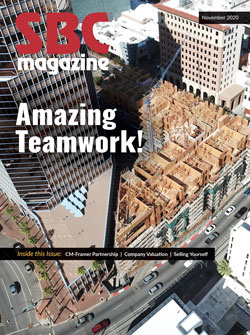A Match Made in the Desert
A Match Made in the Desert
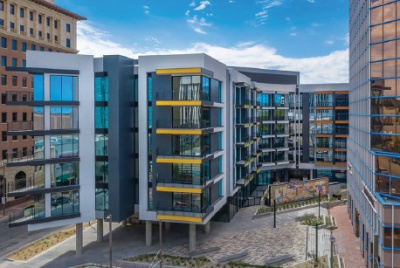
Peanut butter and jelly. Tortilla chips and salsa. Truss Fab and Agra Tech. When two things really complement each other, they create a truly wonderful experience that we tend to seek out whenever we have the opportunity.
This is particularly true in the construction industry where effective communication, coordination, and collaboration are too often undervalued. Yet, when two subcontractors find they both have a commitment to these areas, like TrussFab Components and Agra Tech LLC do, they are able to successfully accomplish projects that others would find impossible. The RendezVous Urban Flats in Tucson, Arizona, is a perfect example.
To fully appreciate how TrussFab and AgraTech pulled off the impossible, and forged a long term partnership in the process, it helps to understand the scope of the project, the challenges they faced, and how their focus on those three “c–words” (communication, coordination and collaboration) were vital in ensuring their mutual success.
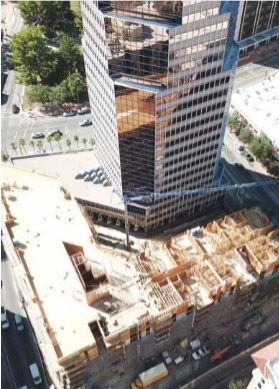
Not Another Tower
The RendezVous story actually starts in 1986, when a developer proposed changing the Tucson skyline in a dramatic way with the construction of two, 23-story glass office towers. Due to a myriad of problems, they were only able to complete one of the two towers. While the large glass edifice at One South Church is still a distinctive part of downtown Tucson, the site of the other tower remained underutilized. The underground parking structure was completed, but nothing was ever constructed above ground. Over time, the space became an urban park and even featured a popular art installment called Ben’s Bells.
Fast forward more than thirty years and a group of local developers purchase the property. While local newspaper articles indicated they were initially considering several construction options, a population and use study led them to settle on a mixed commercial/residential, one-story concrete podium with five stories of wood construction.
UEB Builders, a large general contractor (GC) specializing in multifamily, student housing, and mixed-use projects in the Western U.S., was chosen to head the project. UEB had recently been involved in another large student-housing project for the University of Arizona in downtown Tucson. Framing was almost complete on that project, called “The Mark,” when it fell victim to arson and had to be rebuilt from the ground up.
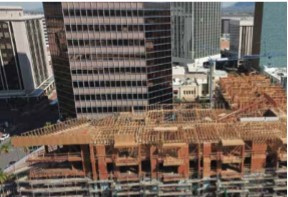
Fortunately, UEB had found in Agra Tech a reliable framing contractor it could trust to do the work quickly and efficiently. The trust created through The Mark project prompted the GC to choose Agra Tech for the RendezVous project. “Our success at completing the rebuild on the first project really made it possible to move forward on the second,” says Alma Broadbent, Agra Tech’s field manager.
According to Alma, RendezVous presented two significant challenges from the outset. The first was the building needed be designed to accommodate the existing bearings of the three-story underground parking structure it was going to be built on. The designers wanted the first floor to serve as downtown commercial and retail space, so it was constructed using steel and post-tension concrete slabs. Structural steel was then run up through the wood framing.
The second challenge was that several of the unique architectural features of the structure suited themselves better to steel framing, but they were initially designed using wood framing. This was due to the relative cost of lumber versus steel at the time as well as the cycle-time savings that could be realized with wood construction.
“We knew this building was going to be a challenge. The large, floor-to-ceiling window openings and exterior finishes were totally unique for wood construction,” says Alma. “While it integrated some structural steel, a lot of the wood framing was left vague on the plans. Wood doesn’t typically do what they wanted to do with it.”
Fortunately, Agra Tech found the perfect partner to help find solutions to these challenges.

Design-Build as You Go
Agra Tech owner, Shem Jessop, drove past another downtown framing project and saw that the wall panels were being manufactured and delivered by Truss Fab. “Shem called me up and asked me if I wanted to bid on a new job they were starting,” recalls Truss Fab owner, Dean Rana. “I told him I already had!” While it is rare for GCs to buy component framing directly from the manufacturer in the Arizona market, Truss Fab had supplied trusses and panels to UEB projects in the past and had been approached on this job prior to UEB choosing Agra Tech to frame the building.
Before these two companies paired up on RendezVous, Agra Tech had been designing the walls in house, but they were glad to bring in Truss Fab’s expertise. “We’ve been doing wall panels for a few years,” says Dean. “Arizona is an uphill market for panels given the framing contractors call all the shots. We knew this would be a great project to be involved in and to get our name on.”
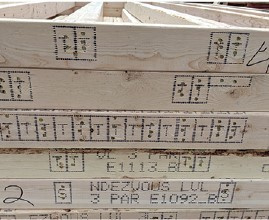
RendezVous fits the classic definition of urban infill. Surrounding the jobsite on one side was the largest commercial building in the city and on the other three sides were busy downtown streets full of established commercial and retail businesses. They were building on top of the only available parking in the area so space for staging and framing was literally non-existent. It was a situation perfectly suited to pre-fabricated wall panel framing.
“When we came on the job, there was little to no wiggle room in the production schedule,” says Dean. “We had a lot of collaborative meetings, made sure we were on the same page with who was doing what and when, and then we got to work.” Three weeks after Truss Fab signed the contract, they shipped the first set of wall panels.
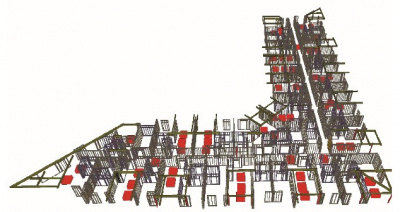
The first hurdle the group had to overcome was getting Agra Tech’s initial wall panel designs done in house by Jerry Barlow from their servers into the hands of Truss Fab’s designers. “It was a massive file. So between the file compression and extraction and the fact we were using different versions of software, not all the file data translated correctly,” recalls Michael Miller, manager of Truss Fab’s panel division. “Eventually, Agra Tech overcame the issue by loading them onto a thumb drive, flying from their offices in Utah and personally handing them to us here in Arizona.”
To give a sense for the size of this project, each floor involved approximately ten trucks fully loaded with components. All the exterior walls were fabricated using fire-resistant treated Doug-Fir, while the rest of the component framing was made of regular Doug-Fir. “We committed to following a two-week cycle,” Michael explains. “One week we manufactured the wall panels and delivered them, the next week we did the same thing with the floor trusses.”
The second hurdle became evident as Truss Fab began manufacturing the wall panels for the second story. Agra Tech was installing the floor trusses when they encountered an issue with the concrete podium. “The post-tension slab was two-and-a-half inches out of level in parts,” says Alma. ”It presented some additional challenges.”
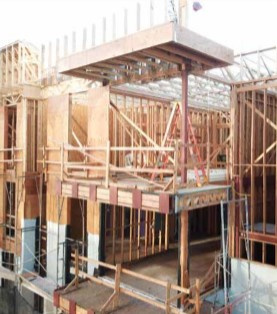
Agra Tech had to take some of the wall panels back down and grind the podium. In other places, Agra Tech had to shim the walls and have the masons come back in and dry pack certain areas. Add to this, the podium dimensions were slightly different than the plans, and the steel columns rising up through the podium and all the floors of wood framing weren’t located exactly where the plans said they should be either. “As a result, we had to take a design-build approach to the first and second wood levels,” says Alma. “The rest of the floors then remained the same once we were able to match the plans with reality. Then we got to the roof, which we had to redesign as well.”
Yet, despite these initial challenges, Truss Fab and Agra Tech were able to get back on their two-week cycle quickly and completely frame one floor per month until they reached the top floor. “To stay on schedule, we’d have to load the trailers the night before so the drivers could haul them out early the next morning,” says Dean. “We have our own trucks and drivers, but for this job we hired an outside carrier so we wouldn’t have to worry that an equipment issue that might cause us to miss a delivery window.”
The delivery windows were extremely tight, with each truck having to arrive and depart within a pre-determined timeframe. That put pressure on the drivers and on Agra Tech’s crane operator. “Those wall panels were sometimes over a thousand pounds each,” says Michael. “Some of the panels were fifteen feet tall and had double and triple studs. It was a challenge for us to get them off the roller tables and stacked.” Dean points out that they typically do 12-foot wall panels made out of non-FRT lumber. This job forced them to take a fresh look at their wall panel operations and change some things in order to better accommodate projects like this in the future.
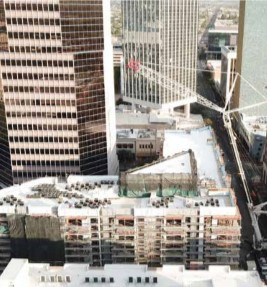
The third hurdle came once the project was fully framed, and the crane used for framing installation needed to be removed. “When Agra Tech was approached about the framing contract for the RendezVous project, one of our first questions we had was how to handle the crane,” explains Jerry. With the triangle-shaped building squeezed onto a city block alongside the tallest building in Tucson, and several six-story buildings surrounding the site, there were few options for crane placement. “The only viable solution was to place the crane as close as we could to the existing glass tower, which obviously presented several limitations to its operation.”
Once the building was completed, the crane then needed to be removed piece by piece — up and over the newly-completed, 90-foot-tall building. “We used a mobile HDT-80 crane for this project, which weighs 51,000 pounds without its counterweights,” says Jerry. “We had to set up a 600-ton crane in the street, 130 feet away, and use the full length of its boom to lift the HDT80 out.” Of course, it took two additional cranes just to install the boom, counterweights and jib on the 600-ton crane. “That meant we had to coordinate nine truckloads of crane accessories as well as three large mobile cranes on one-way streets in downtown Tucson, all while avoiding the suspended wires for two light-rail commuter lines. We really had to rely on the expertise and careful planning of our partner, Stafford Crane Group.”
The final hurdle was subtle, but it could have had a profound impact if Agra Tech and Truss Fab weren’t operating in lock-step throughout the project. “About halfway through the project, UEB was purchased by Katerra,” says Alma. “Fortunately, they kept the same superintendent and most of the same leadership team through the end of the project.” This was significant because they knew the top floor was going to need significant design rework and having the same team in place made it easier to work through all the changes.
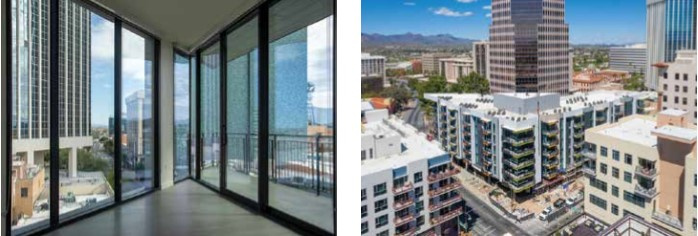
Topping It Off with Ghost Girders
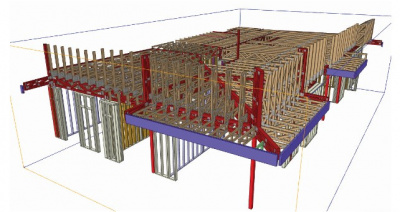
Watch the ghost girder video in the digital edition.
Javier Benites, a veteran designer for Truss Fab, spent hundreds of hours on this project. “I worked very closely with Jerry and Alma all the way through the project,” says Javier. “For the lower levels, everything had to bear to the interior. The three of us made changes here and there on each floor as we went up.” Javier credits Jerry’s skill with building information modeling (BIM) to help them explore options from three perspectives: the functional and aesthetic desires of the building owner, the structural requirements, and its overall buildability.
That collaboration was key once it became clear how the top floor and roof needed to change. “We spent over a month redrawing over eighty truss profiles for the roof,” says Javier. “They wanted all the windows to go from floor to ceiling, and they still wanted a cantilevered roof.” According to Dean and Javier, Truss Fab discovered the limits of their design software.
“We worked through a lot of ideas, sometimes ten iterations for one unit,” Javier explains. “Eventually, we would arrive at a concept we thought would work and we’d send it to the engineer for approval.” He says one of the most challenging design aspects was incorporating hidden, or “ghost,” girders in the exterior, cantilevered portions of the building.
“To get the exterior profiles, flat ceilings, and cantilevers they wanted, we had to create ‘ghost’ girders to hide in the trusses,” says Dean. Javier adds, “unlike the floors below where everything had to bear to the interior, on this top floor, the cantilevered aspects forced bearing to the exterior. The girders were the only way to get that done.” When you consider that Javier also had to account for several exterior vents in the placement of the girder truss webs, his designs had to be perfect.
Not only was this portion of the project exceedingly difficult to design, it was also incredibly difficult to install. “Because these cantilevered roof sections were over six stories up and at the edge, we had to assemble parts of them on the ground and crane them into place,” says Alma. Recall that there was no available space around the building for this assembly, particularly now that the building was almost finished. “Every component needed to be manufactured perfectly and loaded on the truck in just the right order so that they could quickly take it off the truck on the jobsite and assemble each section in very tight space. It took a lot of communication back and forth,” adds Javier. “It’s important to stress though, that this is what we do every day.”
A Strong Partnership
There were several challenges related to this project that could have easily derailed it, or at least set it far behind schedule. Yet, the communication, coordination, and collaboration between Agra Tech and Truss Fab at every step along the way allowed them to navigate these challenges and continue to move forward, ultimately keeping the project on schedule.
It should be noted that any significant setbacks would have been noticed not only by the developers and GC; the public would have been made aware as well. Because of this project’s downtown location and its connection to Tucson’s most iconic building, the local newspaper wrote no less than seven articles about the project, and several more news stories were aired on local television. The whole community was literally watching their progress!
Through it all, Agra Tech and Truss Fab found partners they could rely on. “We do about 2100 multifamily units a year and I have to say these guys are top notch,” says Dean. “They understand how to make off-site construction work well. We look forward to working with them going forward.”
Alma makes a similar observation: “Thanks to that job, when this UEB/Katerra team is doing a wood-framed building in Arizona, we’ll be their go-to framing contractor. And you can bet that Truss Fab will be our choice for the components.”

